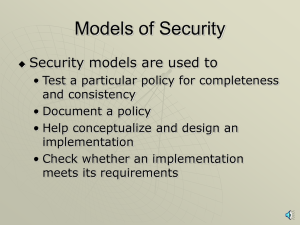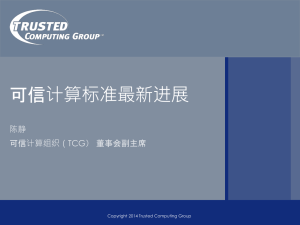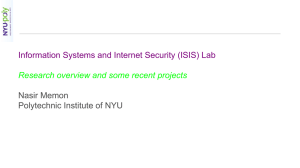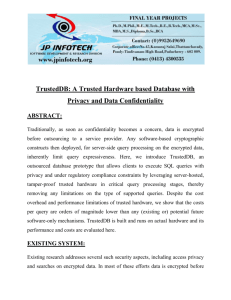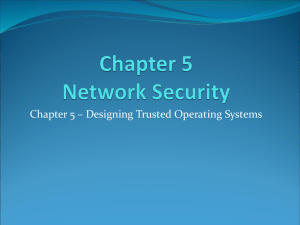Trusted Computing: - Silicon Flatirons
advertisement
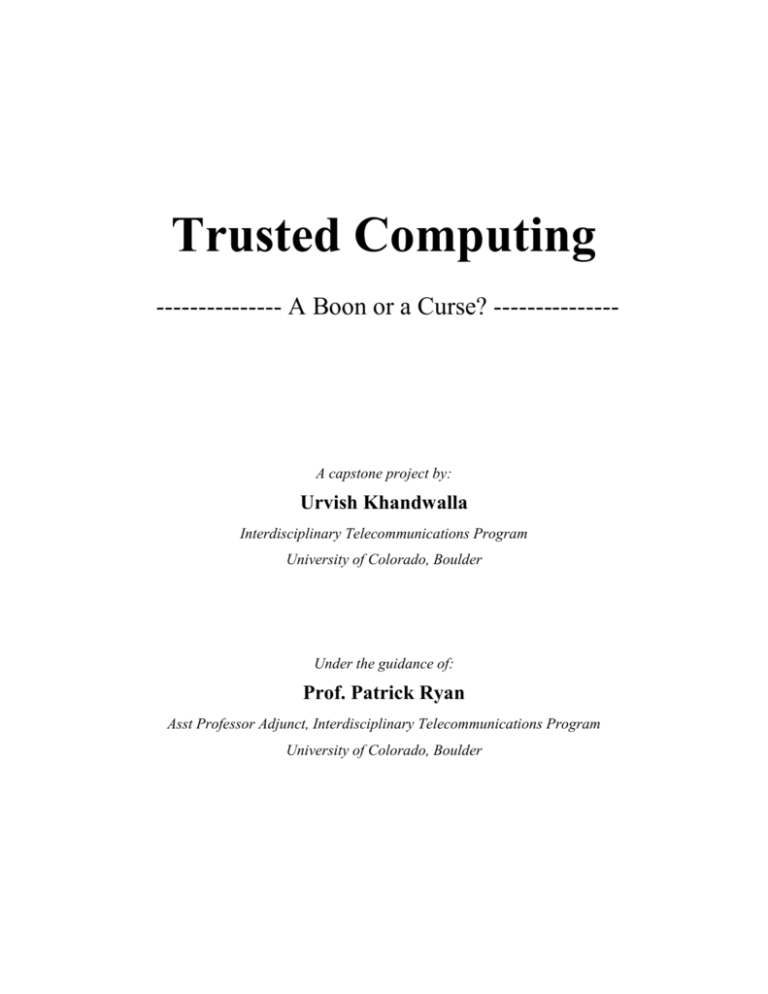
Trusted Computing
--------------- A Boon or a Curse? ---------------
A capstone project by:
Urvish Khandwalla
Interdisciplinary Telecommunications Program
University of Colorado, Boulder
Under the guidance of:
Prof. Patrick Ryan
Asst Professor Adjunct, Interdisciplinary Telecommunications Program
University of Colorado, Boulder
Trusted Computing – Boon or Curse?
TLEN 5700 Capstone Project
TABLE OF CONTENTS
1. Introduction:.................................................................................................................... 2
2. Trust and Security – A subtle difference: ....................................................................... 3
2.1 Trusted Computing: ...................................................................................................... 4
2.1.1
Memory Curtaining: ....................................................................................... 5
2.1.2
Sealed Storage: ............................................................................................... 5
2.1.3
Secure I/O: ...................................................................................................... 6
2.1.4
Remote Attestation: ......................................................................................... 6
2.2 Trusted Platform Subsystem: Architecture ................................................................... 7
3. Operation: ....................................................................................................................... 8
5. Analysis: ......................................................................................................................... 9
5.1 Digital Rights Management (DRM): .................................................................. 10
5.2 Hardware Attacks: .............................................................................................. 10
5.3 Remote Attestation: ............................................................................................. 10
7. References:.................................................................................................................... 14
Urvish Khandwalla
1
Trusted Computing – Boon or Curse?
TLEN 5700 Capstone Project
1. Introduction:
Information Technology has been growing at the speed of light. Internet has been
a backbone to a lot of technologies and businesses. Online transactions, voice over IP,
online gaming, e-commerce and other services have helped with the proliferation of this
technology.
One of the versions of the Moore’s law for the networking industry says that the
internet traffic doubles every year. Also complementing this theory is the Metclafe’s
Law, which states that the usefulness, or utility, of a network equals the square of the
umber of users. The statistics provided by ITU and published by Nielsen/Net Ratings
show that the growth of internet users from 2000 to 2004 has been a whopping 105.5%.[1]
The retail e-commerce business has grown from $45billion in 2000 to $155 billion in
2003 and is predicted to grow to $269 billion in 2005[2]
With such an exponential growth in the internet market the concern for security
had also grown. A lot of threats on the network are looking to defeat systems by
compromising the Confidentiality, Integrity and Availability (CIA) of data. To change
these characteristics of security, a key factor needs to be compromised, viz. ‘trust’. By
trust, it is implied that the respective person/machine/entity is allowed to perform
functions, which only an authorized person/machine/entity can do. Once the trust is
compromised it becomes easier to breach the CIA of data. ‘Trust’ is further discussed in
the next section of this paper.
Fig. 1 shows the dollar amount losses by type in the year 2003. The maximum
losses occurred because of theft of proprietary information and denial of service. These
acts are clear indication of the breach of Confidentiality and Availability respectively.
Urvish Khandwalla
2
Trusted Computing – Boon or Curse?
TLEN 5700 Capstone Project
Fig 1: Dollar Amount of Losses by Type
Hence the occurrence of any fraud, abuse or mishap on an IT network is due to
the breach of trust. Once the trust is broken, the entity can be compromised through
viruses, worms and other sophisticated attacks. So how can this trust factor be
established? How can it be made sure that the entities over the network are trustworthy?
2. Trust and Security – A subtle difference:
Before getting into the details of Trusted Computing (TC) it is important to
understand the difference between trust and security and how they go hand in hand.
Trust:
In terms of security, trust is defined as what you grant to someone [3]
Security:
It is a procedure by which you grant this trust. [3]
Any system is said to be secure if it can provide confidentiality, integrity and
availability to its users. For providing these facets, it is important to maintain trust
between the communicating devices. And to maintain trust, security procedures are
Urvish Khandwalla
3
Trusted Computing – Boon or Curse?
TLEN 5700 Capstone Project
devised. Hence if a system is trustworthy, it doesn’t mean it cannot be compromised.
Being a trustworthy system helps in reducing the probability of system compromise
because it will communicate only with the other trusted computing devices. Hence
trusted devices reduce the possibility of being attacked but they are not completely
immune to attacks.
2.1 Trusted Computing:
Trusted computing (TC) is an industry driven initiative by companies like
Microsoft, Intel, AMD, HP and others to make a ‘more secure PC’. A special interest
group, called the Trusted Computing Group (TCG), formed by the key players of the
computing industry mentioned above, have come together to deliver open building blocks
and common interface stacks across multiple platforms to make the network more
trustworthy and secure.
In simple words, TC is a computing platform which disables the user’s ability to
tamper with the application softwares and securely communicates with the other trusted
parties that pass the compliance.
Hence TC will not support unlicensed softwares. TC will not allow media
duplication. TC will ensure trusted and safe environment for communications.
As mentioned on the TCG website (www.trustedcomputinggroup.org) their
deliverables for TC are:
1. “Hardware and software specifications. These include specifications for
the security subsystem (Trusted Platform Module), implementation
specifications for specific platform types and the programming interface to
the subsystem.
2. White papers and other materials that communicate and advocate the value
of the specifications, the intended applications, and proper use.
3. A certification and compliance program that will allow customers to
identify systems compliant with the specifications of the organization.
Urvish Khandwalla
4
Trusted Computing – Boon or Curse?
TLEN 5700 Capstone Project
Also included are Protection Profiles, documents that describe the IT
security requirements for implementation of the TPM.
4. Marketing programs to increase awareness and education of trusted
computing.
5. Provide advocacy for the proper use of TCG specifications in computing
platforms and applications.” [7]
The key features of Trusted Computing are:
1. Memory Curtaining
2. Sealed Storage
3. Secure I/O
4. Remote attestation
2.1.1
Memory Curtaining:
This is a hardware enforced memory feature which discourages softwares
to read or write into each other’s memory. This provides complete isolation and
avoids infected software to affect the other softwares. Even the operating system
cannot access these memory modules, hence even if the OS is compromised, it
will help not spread the infection.
This feature could be implemented via software, but the problem that
would then arise would be backward compatibility. If this feature is implemented
via software, apart from the tedious software, modules for OS, device drivers and
application software would have to rewritten. This would just make the
implementation cumbersome.
2.1.2 Sealed Storage:
This feature helps by pass the common problem of a safe and its
combination in the same room. If a PC is compromised then it is easy to locate the
keys on the PC and decrypt the required information. Sealed storage is a feature
which enables generation of keys, partly based on the identity of the software and
Urvish Khandwalla
5
Trusted Computing – Boon or Curse?
TLEN 5700 Capstone Project
partly based on the identity of the machine. Hence there would be no need to store
keys. Every time the file is accessed the key is generated. If the access is the
requested by the right software and the right machine, it will give permission to
access the file, else it will fail.
This solves the problem of worms and viruses sending files to other people
from your machine. For e.g. the SirCam worm sent files it found on the infected
machines to random users. Sealed storage would make those files look nothing
but junk because the user who receives this file will not be able to open it as the
keys wouldn’t match, as they are dynamically generated.
2.1.3
Secure I/O:
This feature enables to secure the path from the keyboard to the
application and in turn to the monitor and back. This security is hardware enabled
and hence will discourage the threats posed by applications such as key logging
softwares and screen grabbers. This feature allows the applications to understand
if the information being fed is by a physically present user or by a software
process and thereby allows discouraging forgery of information.
2.1.4
Remote Attestation:
This feature is one of the most controversial and debated upon features.
Through remote attestation, the user on the other end can determine if the
requesting application is altered or not. The way remote attestation works is, a
cryptographic hash is generated for various programs on the PC. If the program is
altered or modified, accordingly a new hash (certificate) is issued to the
application. With the PC user’s consent this certificate is sent to the user on the
other end of the network. This certificate manifests the current state of the
application and allows the user on the other end to accept or reject the
communication. This is a hardware based feature hence it is not possible to
modify these certificates unless one manages to break through the hardware
module.
Urvish Khandwalla
6
Trusted Computing – Boon or Curse?
TLEN 5700 Capstone Project
One of the biggest draw back of this feature is that while issuing the
certificate, it is unable to provide any judgment as to whether the application is
compromised or not. It just issues a hash based on its current state.
2.2 Trusted Platform Subsystem: Architecture
Fig. 2 shows the architecture proposed by the Trusted Computing Group:
Fig. 2: A view of trusted platform subsystem
To provide services to the Trusted Platform (TP), Core Root of Trust for Measurement
(CRTM), Trusted Platform Module (TPM) and Trusted platform Support Service (TSS)
are needed.
These modules are explained as defined by the TCG below:
Core Root of Trust for Measurement (CRTM): “This module provides secure
measurement functions. It measures the integrity metrics and stores them securely.” [4]
Urvish Khandwalla
7
Trusted Computing – Boon or Curse?
TLEN 5700 Capstone Project
Trusted Platform Module (TPM): “It is a platform independent module that gives safe
storage and measurement reporting with other cryptographic keys.” [4] These modules are
different technically, but they are usually put together under the TPM. Hence TPM is
often represented as a microcontroller fixed to the motherboard and stores passwords,
certificates and keys.
Trusted platform Support Service (TSS): “The main function of this module is to
maintain Input/Output operations and communications between the trusted subsystem
and the rest of the platform. It also supports other cryptographic functions such as 3DES
etc, because it would make TPM relatively cheaper.” [4]
3. Operation:
The basic ‘root of trust’ is based upon a set of trusted functions that work as a
foundation stone, over which the other trustworthy conditions are built.
Let us take PC as an example in general. CRTM is either the BIOS boot block or
the entire BIOS. At boot up, the CRTM measures the integrity metrics
[8].
Integrity
metrics are the metrics that show the software state, for e.g. the master boot record, BIOS
and the code from the other firmware. CRTM measures these metrics as hash of the
current state of the software in terms of version, patch level, etc and reports it to the
TPM. The whole process of measurement is done in a chain of trust manner, i.e. the
CRTM initially measures itself, and reports to the TPM. Then it would move up the
hierarchy and measure the BIOS and report the hash to the TPM. Then the BIOS loads
the boot loader and boot loader, in turn, measures the Operating System (OS). OS then
has the access to the TPM to report the software modifications anytime. So, suppose a
pirated version of software was running on the machine, then the OS (in the trusted zone)
would report that to the TPM. No distinction of “good” or “bad” is made by the TPM, it
is just recorded. These decisions are solely left on the user.
TPM, as described before is a microcontroller which has protected storage. It
stores the measurement logs and the Platform Configuration Registers (PCRs). PCRs
store the sequence of measurement values.
Urvish Khandwalla
8
Trusted Computing – Boon or Curse?
TLEN 5700 Capstone Project
When a requesting party asks for the metrics, TPM securely transports the values
stored in the PCR along with their respective logs. This data is encrypted with a private
key of a private – public key pair. The requesting party can then check these metrics and
compare it with the ones, provided by the trusted third party, and evaluate the
trustworthiness of this machine. Accordingly it will make its decision to carry out the
communication in a trusted or a non trusted environment.
Hence a user can operate the device in either of the two modes, namely ‘trusted’
and ‘non-trusted’. If the user runs the machine in a non-trusted mode, then the
applications requiring trusted platform will not be enabled nor would it be able to execute
files that require trusted platform.
4. Key Players:
The current key players in the TC market are listed below along with their
products.
Company
Microsoft
Intel
American Megatrends Inc.
Wave Systems
IBM
AMD
ATMEL
Infineon
National Semiconductors
ST Micro
Transmeta
VIA
Product
The Next Generation Secure Computing Base (NGSCB)
LaGrande, Springdale
AMIBIOS8
EMBASSY (Embedded Application security Subsystem)
TPCA compliant Embedded Security Subsytem (ESS) on
some Thinkpads, Netvista and ThinkCentre systems
Opteron - TPM chips
AT97SC3201 TPM
SLD 9630TT1.1 TPM
SafeKeeper PC 21100
ST19XP18 TPM
Crusoe TPM
C3 (containing Padlock encryption engine)
Release
2004/05
Nov. 2002
5. Analysis:
As discussed above, TC is breaking new technology in terms of security and
controlled distributed computing. But this technology had not yet matured enough to get
everyone under one roof. There are a lot of gray areas which need to be sorted out before
this technology is made public.
Urvish Khandwalla
9
Trusted Computing – Boon or Curse?
TLEN 5700 Capstone Project
5.1 Digital Rights Management (DRM):
It is strongly believed that TC was an initiative forced to cater the Digital Rights
Management (DRM) technology issue and not the security issue as manifested. TCG
members strongly denied this and said that this technology is developed for the purpose
of addressing the security issues without compromising functional integrity, privacy or
individual rights
[7]
. Microsoft had reported at a conference that this technology was the
one that was initiated by the media giants.
The purpose of development of this technology was to allow the media companies
to control the user’s machines. Hence remote attestation would enable to them to learn if
they have their customized media player; sealed storage would store the encryption keys
for the media; secure I/O wouldn’t allow any one to rip media whereas the curtained
memory wouldn’t allow any other software to interfere with the media player. Also with
these features and access to customer’s machines they would be able to redesign their
business models. This technology would help them to sell media in terms of time. For
example, one could download a movie and pay for it every time he watches it.
Hence, from the way it looks, TC was designed to suit the media industry’s
business requirements than the security of a network and the entities on it.
5.2 Hardware Attacks:
TC is built on the assumption that it is difficult and expensive to run Hardware
attacks. But according to Andrew Huang, he successfully broke into the Microsoft Xbox
with equipment which didn’t cost him more than $50. Microsoft Xbox is pretty much a
PC with additional hardware enhancements. Huang explains some sophisticated methods
like Schizophrenic Access Memory (SPAM), Schizophrenic basic Input/Output system
(SPIOS) and others to physically attack a box
[12]
. Hence attacking the TPM is definitely
not impossible but difficult.
5.3 Remote Attestation:
Remote attestation is one of the biggest controversial features of TC. The way
remote attestation fits into the security model of TC is that it makes its owner its own
adversary. It is acceptable that the final aim of attestation is to avoid any software
Urvish Khandwalla
10
Trusted Computing – Boon or Curse?
TLEN 5700 Capstone Project
changes to the machine without the owner’s knowledge but the attestation model
specified by the TCG in its existing design doesn’t allow the owner to make deliberate
software changes to his own machine. From this philosophy, it is clear that the owner
rights are transferred to the attesting third party than the owner of the machine itself.
There are numerous unwanted fall outs to this feature.
5.3.1
Software Lock-in
In future, this feature will instigate the unwanted software interoperability
issues and there by leading to lock-ins. In their specifications TCG doesn’t
provide any clear information as to who will govern the attestation process,
what softwares will be permitted, what is the formal process for software
registrations, and so on. Hence a typical example would be that Microsoft’s
Next Generation Secure Computing Base (NGSCB), a fancy name for trusted
computing platform (previously known as Palladium), would evaluate a
machine to be non-trusted, for it is running Adobe Acrobat reader instead of
Microsoft Word editor.
This will lead to a stronger oligopoly run by the key technology
promoters.
5.3.2
Forced Compliance
Craig Mundie, Microsoft Security Executive, openly admitted that they
wouldn’t mind stepping on some toes if they had to, to make Windows
more secure
[13]
. This is an open opportunity for Microsoft to force its
technology into the market and create a monopoly. Microsoft is absolutely
capable of turning the technology their way to cater their business
demands and needs. With their NGSCB platform, they would develop and
occupy the attestation authority and thereby authorize as to which machine
can be granted trusted or non – trusted access.
Urvish Khandwalla
11
Trusted Computing – Boon or Curse?
TLEN 5700 Capstone Project
5.4 General Public License (GPL):
The GPL states that “Everyone is permitted to copy and distribute verbatim copies
of this license document, but changing it is not allowed.” In other words, it is an effort to
proliferate and motivate young programmers to work towards a non – profit code sharing.
Currently HP and IBM are working towards a TC modified version of GNU/linux. To get
ones code certified, the sponsors have to work through their code, clean it up,
disable/enable certain features, test it against known attacks, document it and send it to
the evaluation lab. The approval tests are expensive for the free GPL code users, but not
unaffordable by the commercial proprietary code holders. Hence even though the free
GPL code will work, it won’t qualify for the TC environment because you won’t have the
certificate specific to the TPM on your machine.
This will lead to extinction of free code programmers, and only the paid
proprietary code will exist. Hence indirectly, TC totally discourages GPL.
6. Conclusion:
Trusted Computing is an important step towards securing the computing device
and thereby securing the network. TC aims to provide a platform where no application
software is tampered. Key features such as memory curtaining, secure I/O, sealed storage
and remote attestation are on which the TC is based. This hardware based secure platform
is indeed a positive move, but some of the functionalities and features of TC are
hampering the overall growth of this promising revolution.
Currently, TC has not matured to a level where it can be made public. There are
indeed TC products out in the market, but those are not sufficient to build a trusted
environment. The current policy pertaining to remote attestations need to be revised.
Also, more concrete steps needs to be defined in deciding who is going to monitor and
evaluate the status of trusted and non trusted environment. The issue of GPL needs to be
taken more seriously else there won’t be any motivation for young programmers to code
free applications, which in turn would defeat the entire purpose of GPL.
Certain serious changes need to be made to the existing proposed security model,
for from the way it looks, it satisfies more needs of the media industry than achieving its
Urvish Khandwalla
12
Trusted Computing – Boon or Curse?
TLEN 5700 Capstone Project
proposed goal of secure computing. TC needs to be more security focused than protecting
the interest of the media industry.
Also Owner override functionality should be enabled in the security model, which
would enable the user’s knowledge based changes to the application software go
undetected in the measurement process. This would allow the users to have the flexibility
to their way of operations and communications. It would also help the users to take the
reigns in their hands than allowing these players at the TCG to control their way of
computing.
Therefore I would conclude that Trusted Computing is a boon, but the current
approach and model definitely makes it a curse in disguise for the end users.
Urvish Khandwalla
13
Trusted Computing – Boon or Curse?
TLEN 5700 Capstone Project
7. References:
1. ITU Statistics, Nielsen/Net Rating URL:
http://www.internetworldstats.com/stats2.htm
2. Bakos, J.Y. (2001) “The Emerging Landscape for Retail E-commerce,” Journal of
Economic Perspectives, 15: 69-80.
3. Lange, K. (2002) “Security – What does “Trust” have to do with it?” , GIAC
Security Essentials Certification, Version 1.4b
4. Hageman, C. (2003) “The Trusted PC: Current Status of Trusted Computing” ,
GSEC Practical Assignment, Version 1.4b
5. Anderson, Ross. “The Economics of Trusted Computing” November 7, 2002.
URL: http://www.netproject.co.uk/presentations/TCPA/ross_anderson.pdf
6. Proudler, Graeme, “What’s in a Trusted Computing Platform?” August 23, 2002.
URL: http://www.informit.com/isapi/product_id~{85459B72-87F3-4433-ACE8D462E7F533F3}/session_id~{204CBB75-FC9F-4E92-B0207408537907A7}/content/index.asp
7. TCG, “Trusted Computing Group (TCG) Frequently Asked Questions” 2003.
URL: http://www.trustedcomputinggroup.org/about/faq
8. TCG, “TCG Main Specification Version 1.1b” February 22, 2002. URL:
http://www.trustedcomputinggroup.org/downloads/tcg_spec_1_1b.zip
9. TCPA, “Trusted Computing Platform Alliance (TCPA) Frequently Asked
Questions, Rev 5.0” July 3, 2002. URL:
http://www.trustedcomputing.org/docs/Website_TCPA%20FAQ_0703021.pdf
10. TCPA, “TPCA Trusted Platform Module Protection Profile Version 1.9.7” July 1,
2002. URL: http://www.trustedcomputing.org/docs/TCPA_TPM_PP_1_9_7.pdf
11. Gordon, A.L., Loeb, M.P., et al., 9th Annual 2004 CSI/FBI Computer Crime and
Security Survey, Computer Security Institute, 2004.
12. Huang, Andrew. “The Trusted PC: Skin-Deep Security.” IEEE Computer October
2002: pp. 103 -105.
13. Berger, M. “Mundie grades Trustworthy Computing after first year” November
13, 2002. URL:
Urvish Khandwalla
14
Trusted Computing – Boon or Curse?
TLEN 5700 Capstone Project
http://www.infoworld.com/articles/hn/xml/02/11/13/021113hntrustworthy.xml?s=
IDGNS
Urvish Khandwalla
15

